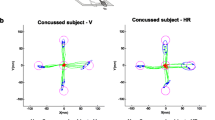Abstract
Recent concussion research has led to the development of computerized test batteries designed to measure working memory and psychomotor speed deficits in acute stage post-concussion. These tests lack a measure of motor control deficits, which may linger well after other symptoms have remitted. For athletes, this may mean returning to play while still uncoordinated or neurologically fragile. The present research involved the development of a visuomotor pointing task designed to induce a speed-accuracy trade off to measure motor planning and execution performance in concussed athletes. Data collected using this tool were contrasted with CogSport, a commercially available computerized test battery designed to assess residual cognitive effects of concussion in athletes. Results suggest that a motor task may be able to detect long-term effects of concussion not measurable with CogSport. If future research can confirm these findings, we suggest that a measure of motor control may need to be added to existing batteries to improve their sensitivity to long term effects.


Similar content being viewed by others
Notes
Response time was log10 transformed to normalize the distribution. This was necessitated by the fact that CogSport reports log10 transformed data by default. Thus, to make performance on each task comparable, the same transformation was performed on the motor task data.
References
Delaney JS, Lacroix VJ, Leclerc S, et al. Concussions among university football and soccer players. Clin J Sport Med 2002; 12 (6): 331–8
Powell JW, Barber-Foss KD. Traumatic brain injury in high school athletes. JAMA 1999; 282 (10): 958–63
Echemendia RJ, Cantu RC. Return to play following sportsrelated mild traumatic brain injury: the role for neuropsychology. Appl Neuropsychol 2003; 10 (1): 48–55
Cantu R, Voy R. Second impact syndrome: a risk in any contact sport. Physician Sportsmed 1995; 23 (6): 27–35
McCrory P. Does second impact syndrome exist? Clin J Sport Med 2001 Jul; 11 (3): 144–9
McCrory PR, Berkovic SF. Second impact syndrome. Neurology 1998 Mar; 50 (3): 677–83
Collie A, Maruff P, Makdissi M, et al. Cog Sport: reliability and correlation with conventional cognitive tests used in postconcussion medical evaluations. Clin J Sport Med 2003 Jan; 13 (1): 28–32
Collie A, Makdissi M, Maruff P, et al. Cognition in the days following concussion: comparison of symptomatic versus asymptomatic athletes. J Neurol Neurosurg Psychiatry 2006 Feb; 77 (2): 241–5
Iverson GL, Lovell MR, Collins MW. Validity of ImPACT for measuring processing speed following sports-related concussion. J Clin Exp Neuropsychol 2005; 27 (6): 683–9
Cremona-Meteyard SL, Geffen GM. Persistent visuospatial attention deficits following mild head injury in Australian Rules football players. Neuropsychologia 1994 Jun; 32 (6): 649–62
Killam C, Cautin RL, Santucci AC. Assessing the enduring residual neuropsychological effects of head trauma in college athletes who participate in contact sports. Arch Clin Neuropsychol 2005 Jul; 20 (5): 599–611
Haaland KY, Temkin N, Randahl G, et al. Recovery of simple motor skills after head injury. J Clin Exp Neuropsychol 1994; 16 (3): 448–56
Kuhtz-Buschbeck JP, Stolze H, Gölge M, et al. Analyses of gait, reaching, and grasping in children after traumatic brain injury. Arch Phys Med Rehabil 2003 Mar; 84 (3): 424–30
Haggard P, Miall RC, Wade D, et al. Damage to cerebellocortical pathways after closed head injury: a behavioural and magnetic resonance imaging study. J Neurol Neurosurg Psychiatry 1995 Apr; 58 (4): 433–8
Guskiewicz KM. Postural stability assessment following concussion: one piece of the puzzle. Clin J Sport Med 2001 Jul; 11 (3): 182–9
Guskiewicz KM, Ross SE, Marshall SW. Postural stability and neuropsychological deficits after concussion in collegiate athletes. J Athlet Train 2001 Sep; 36 (3): 263–73
Heitger MH, Jones RD, Dalrymple-Alford JC, et al. Motor deficits and recovery during the first year following mild closed head injury. Brain Inj 2006 Jul; 20 (8): 807–24
Fitts PM. The information capacity of the human motor system in controlling the amplitude of movement. J Exp Psychol Gen 1954 Jun; 47 (6): 381–91
Steenhuis R, Bryden M. Different dimensions of hand preference that relate to skilled and unskilled activities. Cortex 1989 Jun; 25 (2): 289–304
Makdissi M, Collie A, Maruff P, et al. Computerised cognitive assessment of concussed Australian Rules footballers. Br J Sports Med 2001 Oct; 35 (5): 354–60
Collie A, Darby D, Maruff P. Computerised cognitive assessment of athletes with sports related head injury. Br J Sports Med 2001 Oct; 35 (5): 297–302
Acknowledgements
This work was supported by National Sciences and Engineering Research Council (NSERC) of Canada, and Canada Research Chair (Tier II) awards to James Danckert. The authors have no conflicts of interest that are directly relevant to the content of this study.
Author information
Authors and Affiliations
Corresponding author
Rights and permissions
About this article
Cite this article
Locklin, J., Bunn, L., Roy, E. et al. Measuring Deficits in Visually Guided Action Post-Concussion. Sports Med 40, 183–187 (2010). https://doi.org/10.2165/11319440-000000000-00000
Published:
Issue Date:
DOI: https://doi.org/10.2165/11319440-000000000-00000



